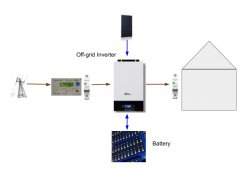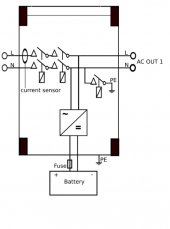EliteSolar
New Member
- Joined
- Sep 22, 2020
- Messages
- 90
Hi Guys,
So I have been thinking to build a new setup without batteries. I need a hybrid inverter , If I am asking 1100watt load and the solar panel only provide 1000watt , then the grid will supply 100watt more to meet the 1100w load demand. I'm thinking around 5kw output inverter.
SHORT READ : I want an AIO hybrid inverter that can split the load between the grid and my PV panels, I look at the EASUN models , like REVO II , SV II and SV IV. I want to pay max 800euro. What are the differences between those models ? SV II and SV IV look about the same just led lights and wifi and 500w more inverter output power ? Do people know if there are any other differences ? Which other models can do that ? Some people where complaining the REVO II is not very good and not true 5kw inverter and has some problems... what about SV II and SV IV ? Or other models ? It's not very clear which models can do that...
Is there an ideal voltage range when wanting to convert PV DC to AC directly ? Some people say over 200V , some say ideally 350V ? Some say 450? Or is it very model specific ?
EXTRA INFO : I live in Greece and I get lots of sun especially the whole summer doesnt have any clouds for 6 months and I basically want to use the power directly from the solar panels . For me batteries don't make any sense at the moment because I have to pay 580euros for 24V 50AH Lifepo4 , just to be able to save 1.2kwhr per day ? Not a lot. A quick math says that a 1.2kwhr battery holds 30cents worth of energy per day or 110~euro worth of energy per year ( not a lot ) so basically "kinda" means 5 years just to pay off the battery , id rather put a couple more solar panels ? Also its supposed to be better to convert PV DC to AC directly , better efficiency.. Am I missing something? That's why I want to build a batteryless system ( I have access to cheap night grid power ) .
Many thanks
ES
So I have been thinking to build a new setup without batteries. I need a hybrid inverter , If I am asking 1100watt load and the solar panel only provide 1000watt , then the grid will supply 100watt more to meet the 1100w load demand. I'm thinking around 5kw output inverter.
SHORT READ : I want an AIO hybrid inverter that can split the load between the grid and my PV panels, I look at the EASUN models , like REVO II , SV II and SV IV. I want to pay max 800euro. What are the differences between those models ? SV II and SV IV look about the same just led lights and wifi and 500w more inverter output power ? Do people know if there are any other differences ? Which other models can do that ? Some people where complaining the REVO II is not very good and not true 5kw inverter and has some problems... what about SV II and SV IV ? Or other models ? It's not very clear which models can do that...
Is there an ideal voltage range when wanting to convert PV DC to AC directly ? Some people say over 200V , some say ideally 350V ? Some say 450? Or is it very model specific ?
EXTRA INFO : I live in Greece and I get lots of sun especially the whole summer doesnt have any clouds for 6 months and I basically want to use the power directly from the solar panels . For me batteries don't make any sense at the moment because I have to pay 580euros for 24V 50AH Lifepo4 , just to be able to save 1.2kwhr per day ? Not a lot. A quick math says that a 1.2kwhr battery holds 30cents worth of energy per day or 110~euro worth of energy per year ( not a lot ) so basically "kinda" means 5 years just to pay off the battery , id rather put a couple more solar panels ? Also its supposed to be better to convert PV DC to AC directly , better efficiency.. Am I missing something? That's why I want to build a batteryless system ( I have access to cheap night grid power ) .
Many thanks
ES




